Comprehensive Assessment and Empirical Research on Green and Low-Carbon Technologies in the Steel Industry
Abstract
1. Introduction
2. Establishment of an Evaluation System
2.1. Assessment of Green and Low-Carbon Technologies in the Steel Industry
2.2. The Basis and Influencing Factors of Technical Evaluation
3. Comprehensive Assessment Model of Green and Low-Carbon Technologies in the Steel Industry
3.1. Selection of Assessment Methodology
3.2. Standardisation of Evaluation Indicators
3.3. Determination of Indicator Weights
3.4. Integrated Assessment Method Based on Grey Correlation Analysis-TOPSIS Improvement
4. Assessment of Examples of Green and Low-Carbon Technologies in the Steel Industry
4.1. Technology Selection and Parameter Acquisition
4.2. Analysis of the Assessment Process and Results
4.3. Integrated Assessment
4.4. Technology Preference Assessment
4.5. Uncertainty Analysis
5. Conclusions
- (1)
- By constructing a top-down, three-level structure of the comprehensive evaluation index system of green and low-carbon technologies in the iron and steel industry, it was found that technical performance indicators had the most significant impact on the comprehensive assessment results, the second was the economic index, and the least impact was from the promotion index. The weights of the eleven index layers were calculated and compared, and the energy saving index had the greatest impact on the comprehensive evaluation of technology. The of CO2 emission reduction indicators and economic benefit indicators also had a considerable impact on , and the calculation results were consistent with fundamental data analysis.
- (2)
- The comprehensive assessment of green and low-carbon technologies in the iron and steel industry found that under different preference coefficients, Technology 10 was the closest to the positive ideal solution, the farthest from the negative ideal solution, and had the highest correlation with the ideal solution and the highest relative closeness, with the best comprehensive assessment result among the assessed technologies among a number of assessment indicators. The technical parameters of Technology 10 in several indicators with large weights, such as energy saving, carbon dioxide emission reduction, and economic benefits, were better than other technical indicator parameters, so the final comprehensive assessment results were optimal. That is, when λ = 0, 0.5, 1, was 0.580, 0.670, and 0.794, respectively.
- (3)
- By evaluating the three technology preferences in the steel industry, it was concluded that Technology 10 was closest to the positive ideal solution and furthest from the negative ideal solution. It had the highest correlation and relative closeness to the most ideal solution, and the assessment result in the enterprise preference decision was optimal among the evaluated technologies. By studying environmental preferences, it was concluded that Technology 10 outperformed the other technologies in both energy savings and CO2 emission reduction, two indicators with considerable weighting, and had the best final assessment result. However, its performance in resource recovery rate was average. Focusing on the diffusibility of the technology to assess the technology, it was found that technology maturity, technological sophistication, technology diffusion potential (expected penetration rate), and technological stability all performed optimally on the four indicators. Technology 1 had the best assessment results among the assessed technologies in terms of diffusion and application preference decision making. The main influencing factor affecting the comprehensive level of the technology was the performance of the technology, followed by the economic benefits of the technology; at the same time, the results of the uncertainty analysis showed that fluctuations in the technical parameters will not only affect the performance of the technology itself, but will also affect the indicator weights and the comprehensive evaluation results of the technology, but have a smaller impact on the indicator weights and a more considerable impact on the comprehensive evaluation results of the technology.
Author Contributions
Funding
Data Availability Statement
Conflicts of Interest
References
- Qi, X.; Han, Y. Research on the evolutionary strategy of carbon market under “dual carbon” goal: From the perspective of dynamic quota allocation. Energy 2023, 274, 127265. [Google Scholar] [CrossRef]
- Zhang, B.; Yu, L.; Sun, C. How does urban environmental legislation guide the green transition of enterprises? Based on the perspective of enterprises’ green total factor productivity. Energy Econ. 2022, 110, 106032. [Google Scholar] [CrossRef]
- Gu, Y.; Liu, W.; Wang, B.; Tian, B.; Yang, X.; Pan, C. Analysis and Prediction of Energy, Environmental and Economic Potentials in the Iron and Steel Industry of China. Processes 2023, 11, 3258. [Google Scholar] [CrossRef]
- Ouyang, Y.; Guo, J. Carbon capture and storage investment strategy towards the dual carbon goals. J. Asian Econ. 2022, 82, 101527. [Google Scholar] [CrossRef]
- Liu, X.; Peng, R.; Bai, C.; Chi, Y.; Li, H.; Guo, P. Technological roadmap towards optimal decarbonization development of China’s iron and steel industry. Sci. Total Environ. 2022, 850, 157701. [Google Scholar] [CrossRef] [PubMed]
- Zhou, Z.; Ma, Z.; Lin, X. Carbon emissions trading policy and green transformation of China’s manufacturing industry: Mechanism assessment and policy implications. Front. Environ. Sci. 2022, 10, 984612. [Google Scholar] [CrossRef]
- Griffin, P.W.; Hammond, G.P. Industrial energy use and carbon emissions reduction in the iron and steel sector: A UK perspective. Appl. Energy 2019, 249, 109–125. [Google Scholar] [CrossRef]
- Huang, D.; Dinga, C.D.; Wen, Z.; Razmadze, D. Industrial-environmental management in China’s iron and steel industry under multiple objectives and uncertainties. J. Environ. Manag. 2022, 310, 114785. [Google Scholar] [CrossRef]
- Gu, Y.; Pan, C.; Sui, Y.; Wang, B.; Jiang, Z.; Wang, C.; Liu, Y. CO2 emission accounting and emission reduction analysis of the steel production process based on the material-energy-carbon correlation effect. Environ. Sci. Pollut. Res. 2023, 1–18. [Google Scholar] [CrossRef] [PubMed]
- Golonka, K.A.; Brennan, D.J. Costs and environmental impacts in pollutant treatment: A case study of sulphur dioxide emissions from metallurgical smelters. Process Saf. Environ. Prot. 1997, 75, 232–244. [Google Scholar] [CrossRef]
- Liu, S.; Forrest, J.; Vallee, R. Emergence and development of grey systems theory. Kybernetes 2009, 38, 1246–1256. [Google Scholar] [CrossRef]
- Palanisamy, G.; Jung, H.-Y.; Sadhasivam, T.; Kurkuri, M.D.; Kim, S.C.; Roh, S.-H. A comprehensive review on microbial fuel cell technologies: Processes, utilization, and advanced developments in electrodes and membranes. J. Clean. Prod. 2019, 221, 598–621. [Google Scholar] [CrossRef]
- Jia, X.X.; Li, S.; Han, D.P.; Chen, R.P.; Yao, Z.Y.; Ning, B.A.; Gao, Z.X.; Fan, Z.C. Development and perspectives of rapid detection technology in food and environment. Crit. Rev. Food Sci. Nutr. 2022, 62, 4706–4725. [Google Scholar] [CrossRef]
- Mohana, M.; Da Silveira, A.C.; Suvetha, V.; Subashini, P.; Ghinea, G.; Santos, C.A.S. Technology Enhanced Mulsemedia Learning (TEML) for Learners with Dyslexia. In Proceedings of the 2023 ACM International Conference on Interactive Media Experiences Workshops, Nantes, France, 12–15 June 2023; pp. 62–65. [Google Scholar]
- Yang, H.; Lu, J.; Lu, H.; Gao, Y.; Liu, X.; Liu, H. Key technologies of low-carbon-oriented intelligent travel service for urban rail transit based on MaaS. In Proceedings of the International Conference on Intelligent Traffic Systems and Smart City (ITSSC 2021), Zhengzhou, China, 19–22 November 2021; Volume 12165, pp. 172–176. [Google Scholar]
- Zhao, K.; Xue, H.; Yang, F.; Zhao, L. Probability prediction of crack growth rate of environmentally assisted cracks of nickel-based alloys based on Latin hypercube sampling. Int. J. Press. Vessel. Pip. 2019, 172, 391–396. [Google Scholar] [CrossRef]
- Cui, L.; Liu, M.; Yuan, X.; Wang, Q.; Ma, Q.; Wang, P.; Hong, J.; Liu, H. Environmental and economic impact assessment of three sintering flue gas treatment technologies in the iron and steel industry. J. Clean. Prod. 2021, 311, 127703. [Google Scholar] [CrossRef]
- Wang, Y.; Wen, Z.; Li, H. Symbiotic technology assessment in iron and steel industry based on entropy TOPSIS method. J. Clean. Prod. 2020, 260, 120900. [Google Scholar] [CrossRef]
- Kim, M.S.; Lee, E.B.; Jung, I.H.; Alleman, D. Risk assessment and mitigation model for overseas steel-plant project investment with analytic hierarchy process—Fuzzy inference system. Sustainability 2018, 10, 4780. [Google Scholar] [CrossRef]
- Li, C.; Zhang, F.; Zhu, T.; Feng, T.; An, P. Evaluation and correlation analysis of land use performance based on entropy-weight TOPSIS method. Trans. Chin. Soc. Agric. Eng. 2013, 29, 217–227. [Google Scholar]
- Li, K.; Zou, D.; Li, H. Environmental regulation and green technical efficiency: A process-level data envelopment analysis from Chinese iron and steel enterprises. Energy 2023, 277, 127662. [Google Scholar] [CrossRef]
- Ratanakuakangwan, S.; Morita, H. An efficient energy planning model optimizing cost, emission, and social impact with different carbon tax scenarios. Appl. Energy 2022, 325, 119792. [Google Scholar] [CrossRef]
- Zhong, Z.W.; Liu, Z.J.; Mu, L.L.; Kang, X.L. Study on Safety Evaluation for Construction Sites Based on Fuzzy-AHP and Grey Correlation Analysis. Appl. Mech. Mater. 2012, 166, 2609–2614. [Google Scholar] [CrossRef]
- Chauhan, S.S.; Trivedi, M.K. Assessment of Surface Water Quality Index of Gwalior-Chambal Region Using Fuzzy-Based Approach. J. Inst. Eng. India Ser. A 2023, 104, 1–17. [Google Scholar] [CrossRef]
- Liu, P. Multi-attribute decision-making method research based on interval vague set and TOPSIS method. Technol. Econ. Dev. Econ. 2009, 15, 453–463. [Google Scholar] [CrossRef]
- Lin, H.; Wang, Z.J. Linguistic multi-attribute group decision making with risk preferences and its use in low-carbon tourism destination selection. Int. J. Environ. Res. Public Health 2017, 14, 1078. [Google Scholar] [CrossRef] [PubMed]
- Lu, X.; Zhang, Y.; Li, J.; Duan, K. Measuring the urban land use efficiency of three urban agglomerations in China under carbon emissions. Environ. Sci. Pollut. Res. 2022, 29, 36443–36474. [Google Scholar] [CrossRef] [PubMed]
- Deng, C.; Liu, L.; Li, H.; Peng, D.; Wu, Y.; Xia, H.; Zhang, Z.; Zhu, Q. A data-driven framework for spatiotemporal characteristics, complexity dynamics, and environmental risk evaluation of river water quality. Sci. Total Environ. 2021, 785, 147134. [Google Scholar] [CrossRef]
- Toufigh, V.; Pahlavani, H. Probabilistic-based analysis of MSE walls using the Latin hypercube sampling method. Int. J. Geomech. 2018, 18, 04018109. [Google Scholar] [CrossRef]
- Tang, J.; Zhu, H.-L.; Liu, Z.; Jia, F.; Zheng, X.-X. Urban sustainability evaluation under the modified TOPSIS based on grey relational analysis. Int. J. Environ. Res. Public Health 2019, 16, 256. [Google Scholar] [CrossRef]
- Malek, A.; Ebrahimnejad, S.; Tavakkoli-Moghaddam, R. An improved hybrid grey relational analysis approach for green resilient supply chain network assessment. Sustainability 2017, 9, 1433. [Google Scholar] [CrossRef]
- Wenhai, N.; Li, L.; Hao, F.; Bin, S.; Dapeng, L. Evaluation System and Application for Power Infrastructure Projects Based on Improved TOPSIS. J. Syst. Manag. 2021, 30, 1207. [Google Scholar]
- Aikhuele, D.; Turan, F. An integrated fuzzy dephi and interval-valued intuitionistic fuzzy M-Topsis model for design concept selection. Pak. J. Stat. Oper. Res. 2017, 13, 425–438. [Google Scholar] [CrossRef]
- Sarwar, M. Decision-making approaches based on color spectrum and D-TOPSIS method under rough environment. Comput. Appl. Math. 2020, 39, 291. [Google Scholar] [CrossRef]
- Wu, J.; Sun, J.; Zha, Y.; Liang, L. Ranking approach of cross-efficiency based on improved TOPSIS technique. J. Syst. Eng. Electron. 2011, 22, 604–608. [Google Scholar] [CrossRef]
- Zhou, W.; Li, H.; Zhang, L.; Tian, H.; Fu, M. Evaluation analysis and promotion paths of regional green innovation vitality in China. Grey Syst. Theory Appl. 2023, 13, 747–766. [Google Scholar] [CrossRef]
- Çelikbilek, Y.; Tüysüz, F. An in-depth review of theory of the TOPSIS method: An experimental analysis. J. Manag. Anal. 2020, 7, 281–300. [Google Scholar] [CrossRef]
- Wang, X.; Yang, Z. Application of fuzzy optimization model based on entropy weight method in atmospheric quality evaluation: A case study of Zhejiang province, China. Sustainability 2019, 11, 2143. [Google Scholar] [CrossRef]
- Wang, N.; Chen, X.; Wu, G.; Chang, Y.-C.; Yao, S. A short-term based analysis on the critical low carbon technologies for the main energy-intensive industries in China. J. Clean. Prod. 2018, 171, 98–106. [Google Scholar] [CrossRef]
- He, F.; Liu, Z.-Y.; Xing, Y.-K.; Gao, Y.-B.; Mao, X.-Q. Co-control effect evaluation of the energy saving and emission reduction measures in Chinese cement industry. Adv. Clim. Chang. Res. 2021, 17, 400. [Google Scholar]
- Zhang, G.; Gao, Y.; Li, G. Research on Digital Transformation and Green Technology Innovation—Evidence from China’s Listed Manufacturing Enterprises. Sustainability 2023, 15, 6425. [Google Scholar] [CrossRef]
- Fan, Z.; Friedmann, S.J. Low-carbon production of iron and steel: Technology options, economic assessment, and policy. Joule 2021, 5, 829–862. [Google Scholar] [CrossRef]
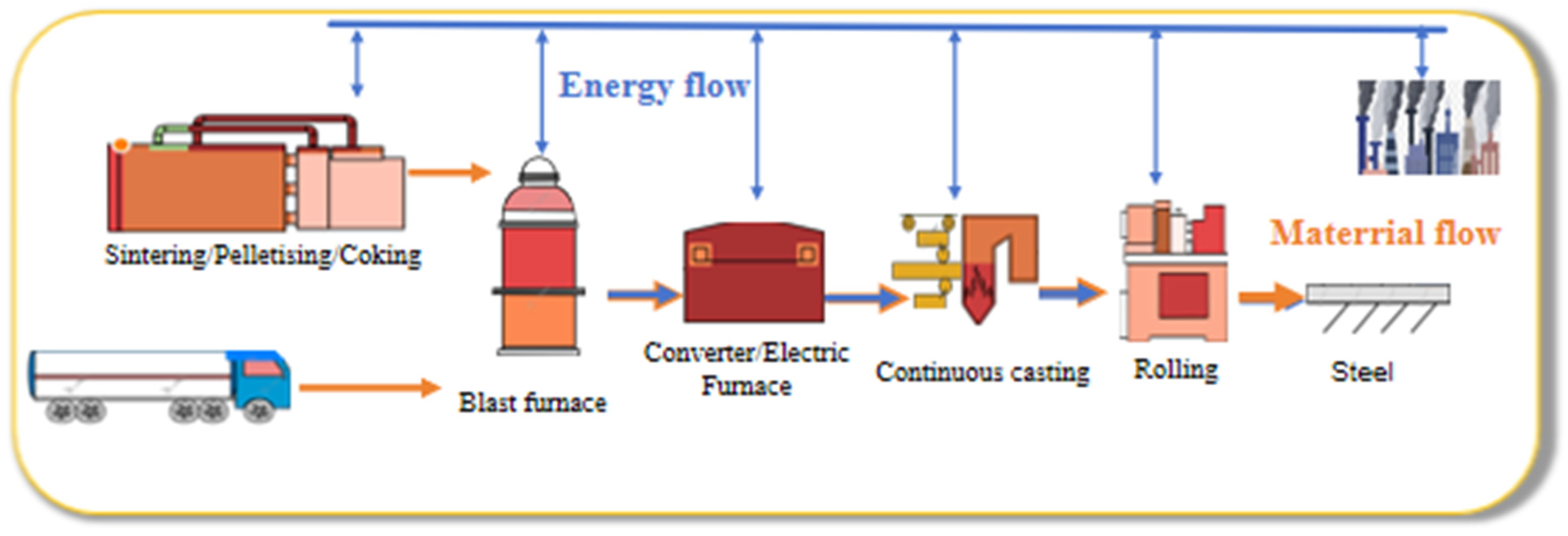
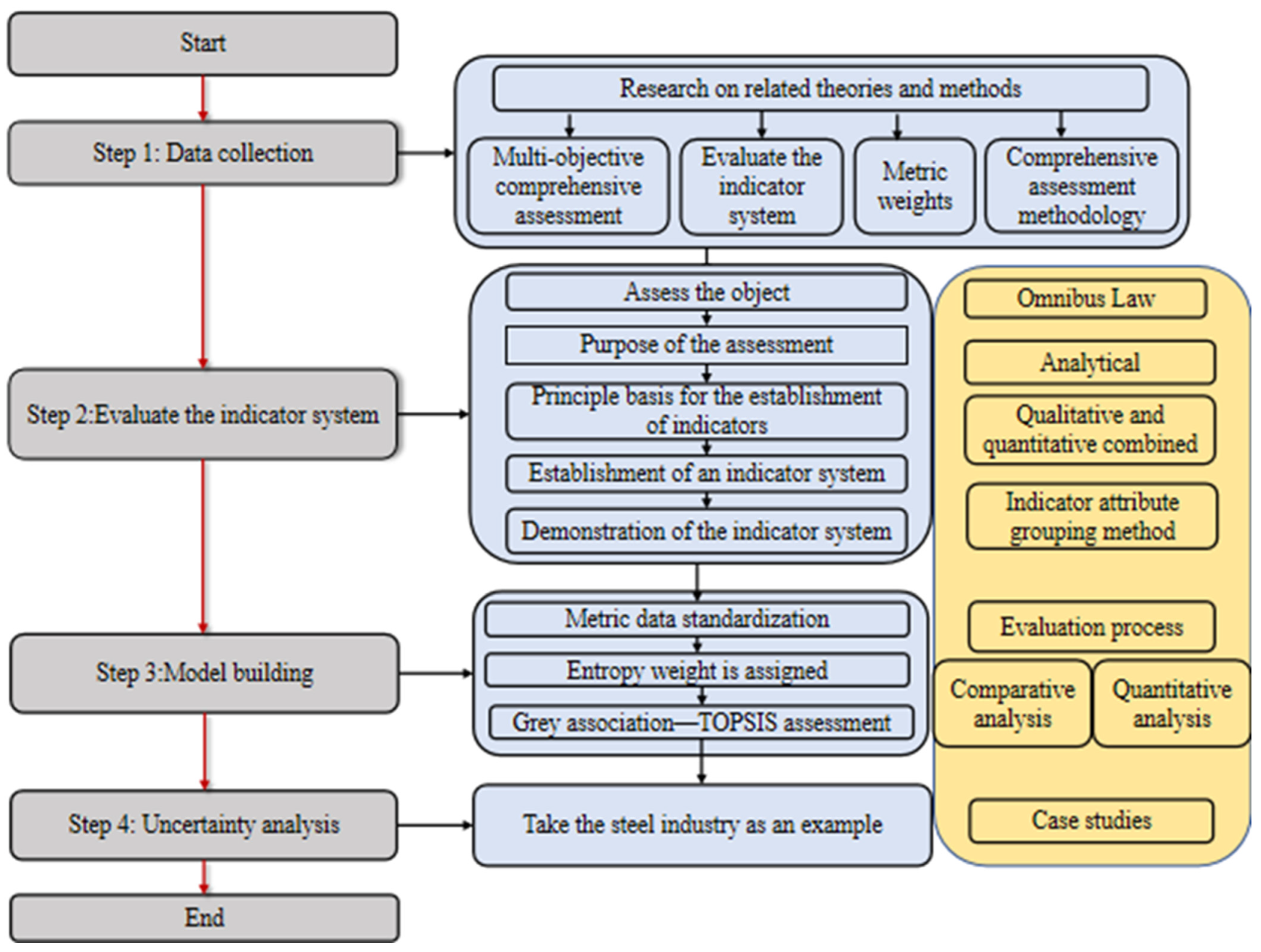
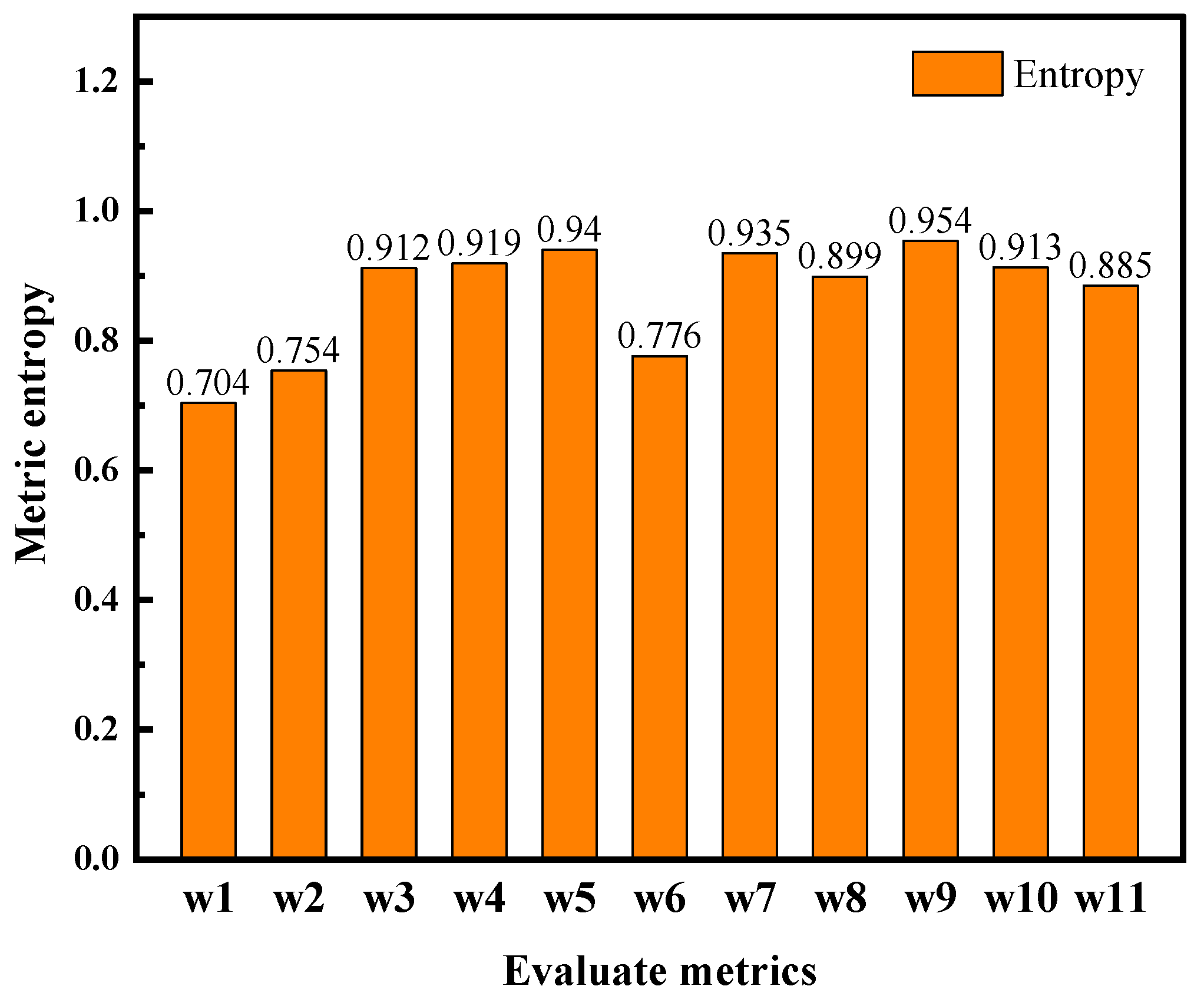
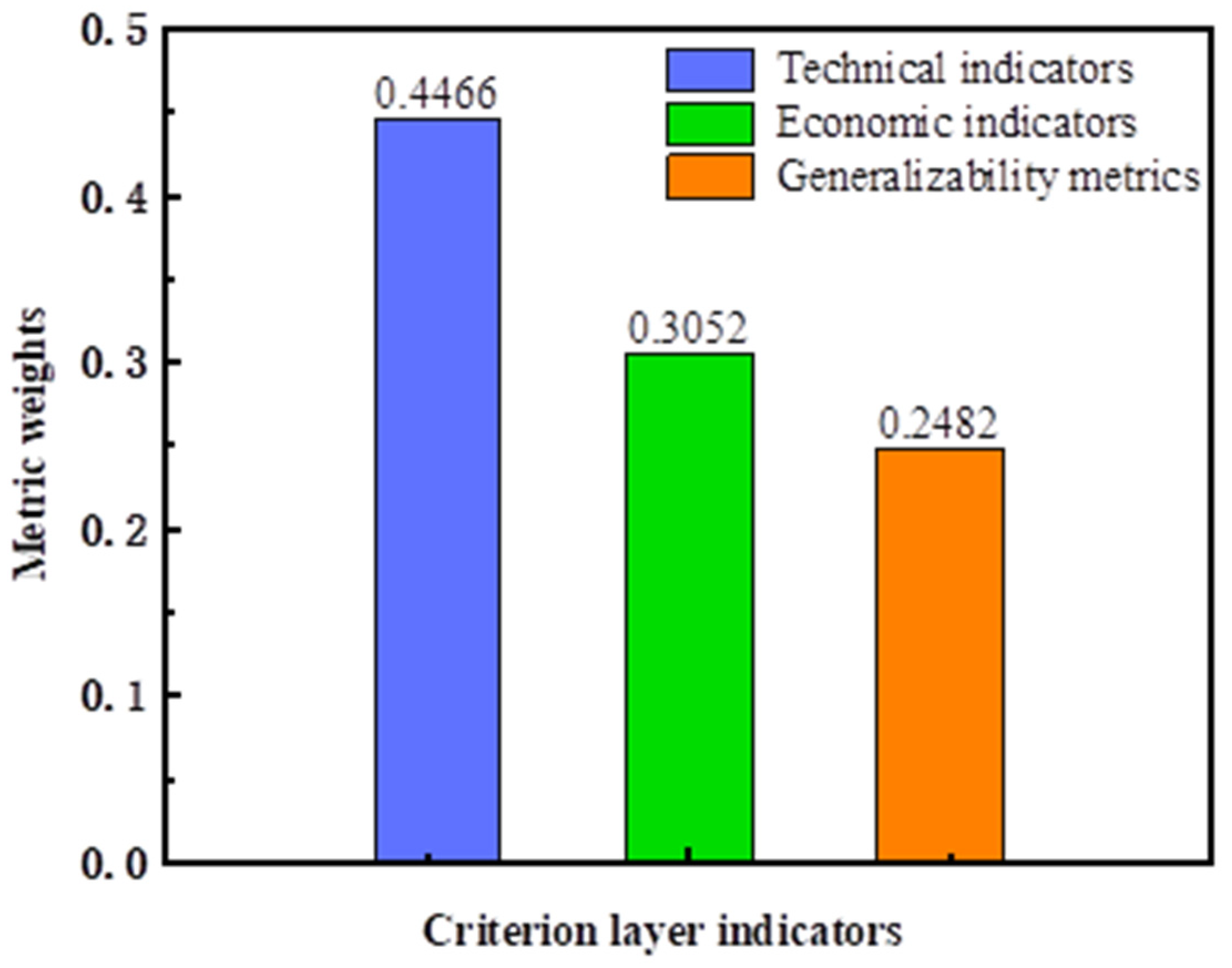
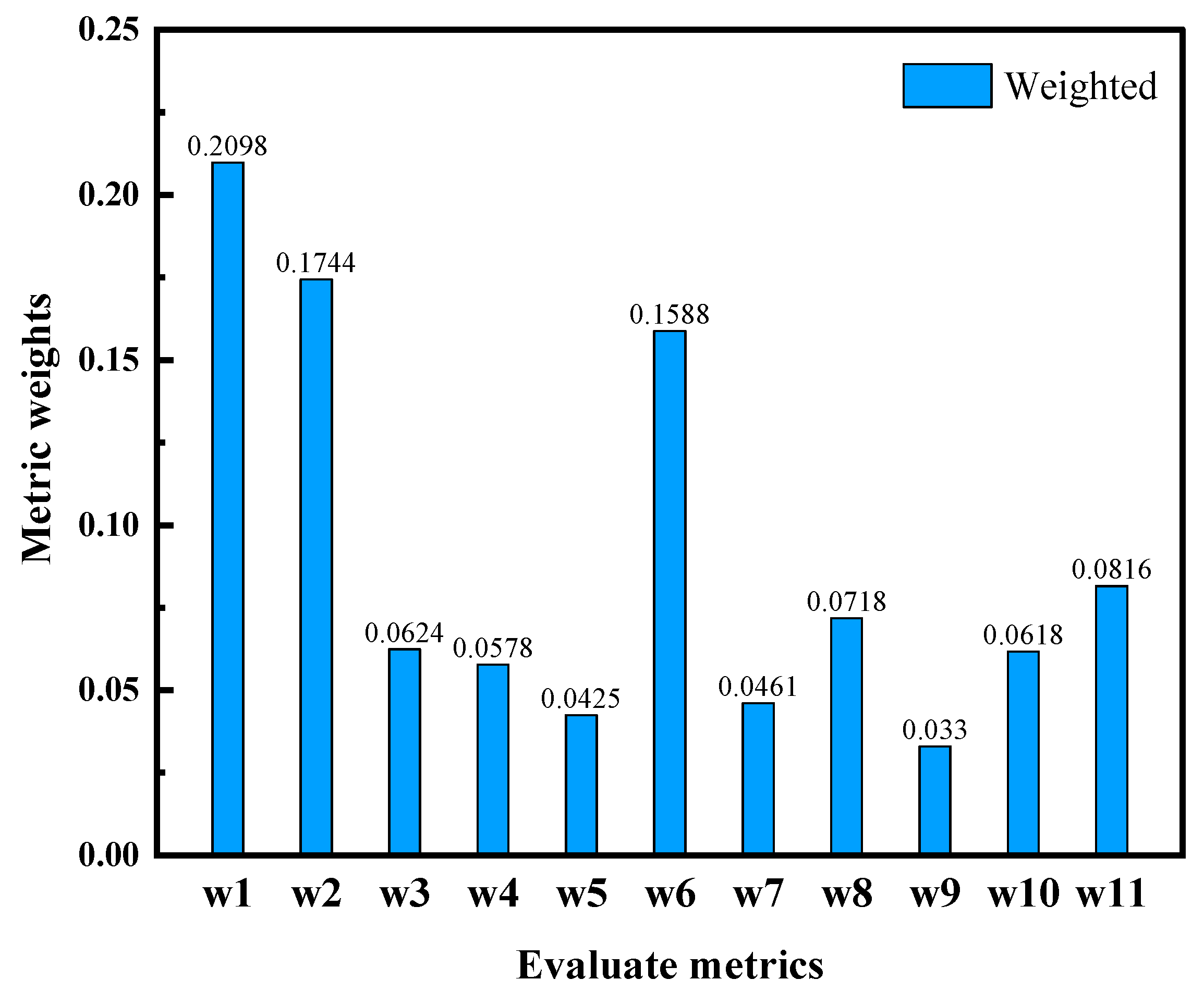
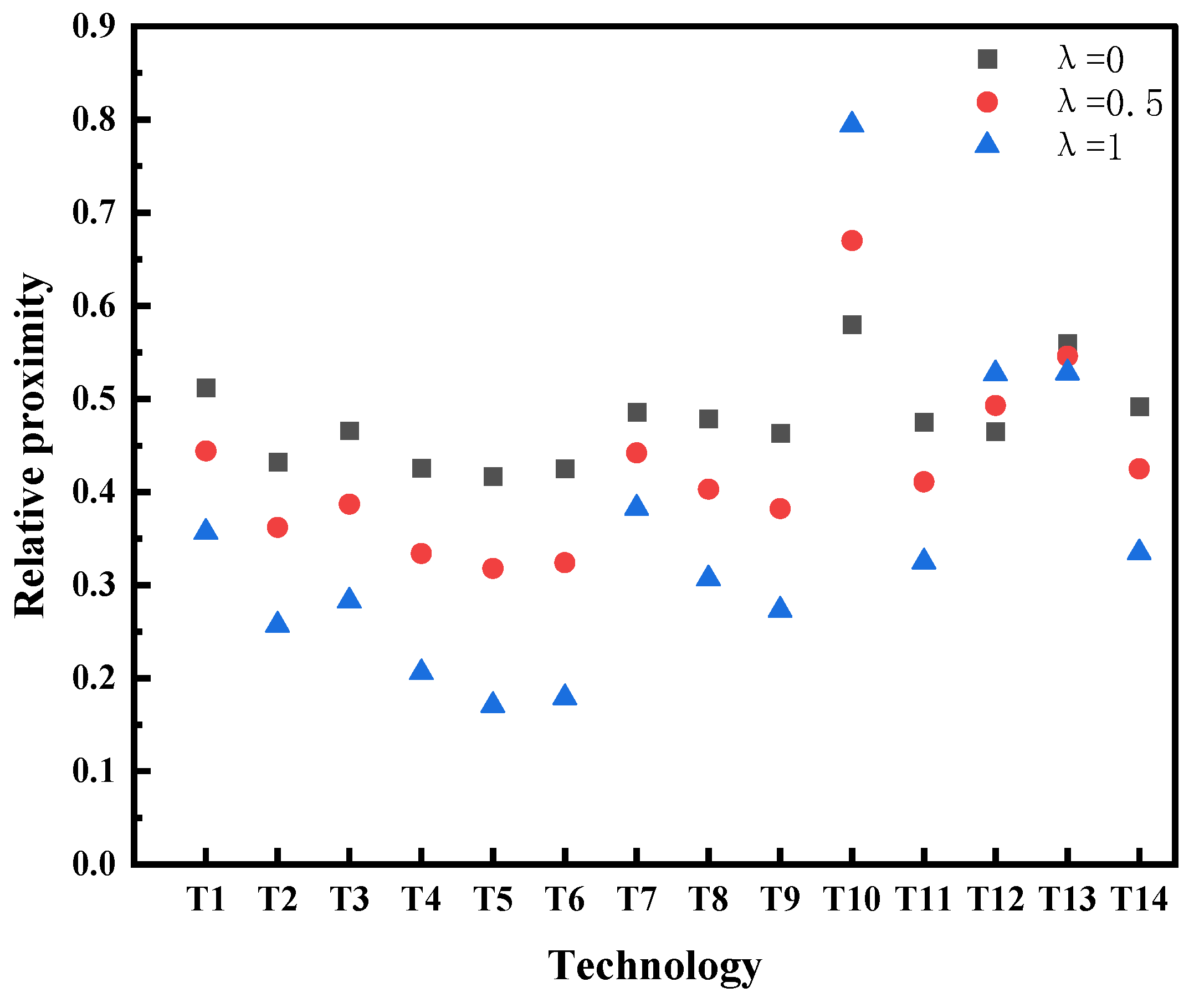
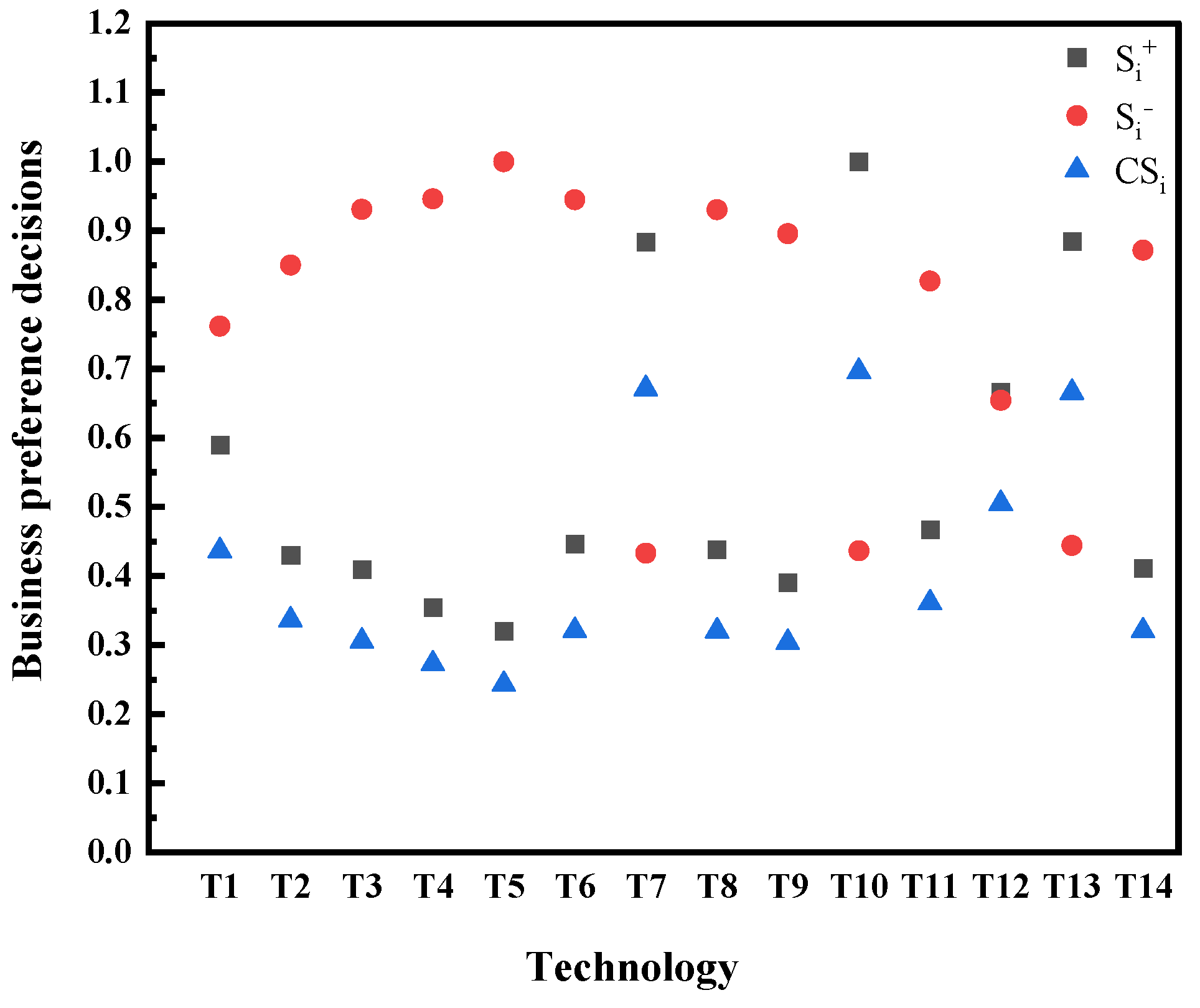
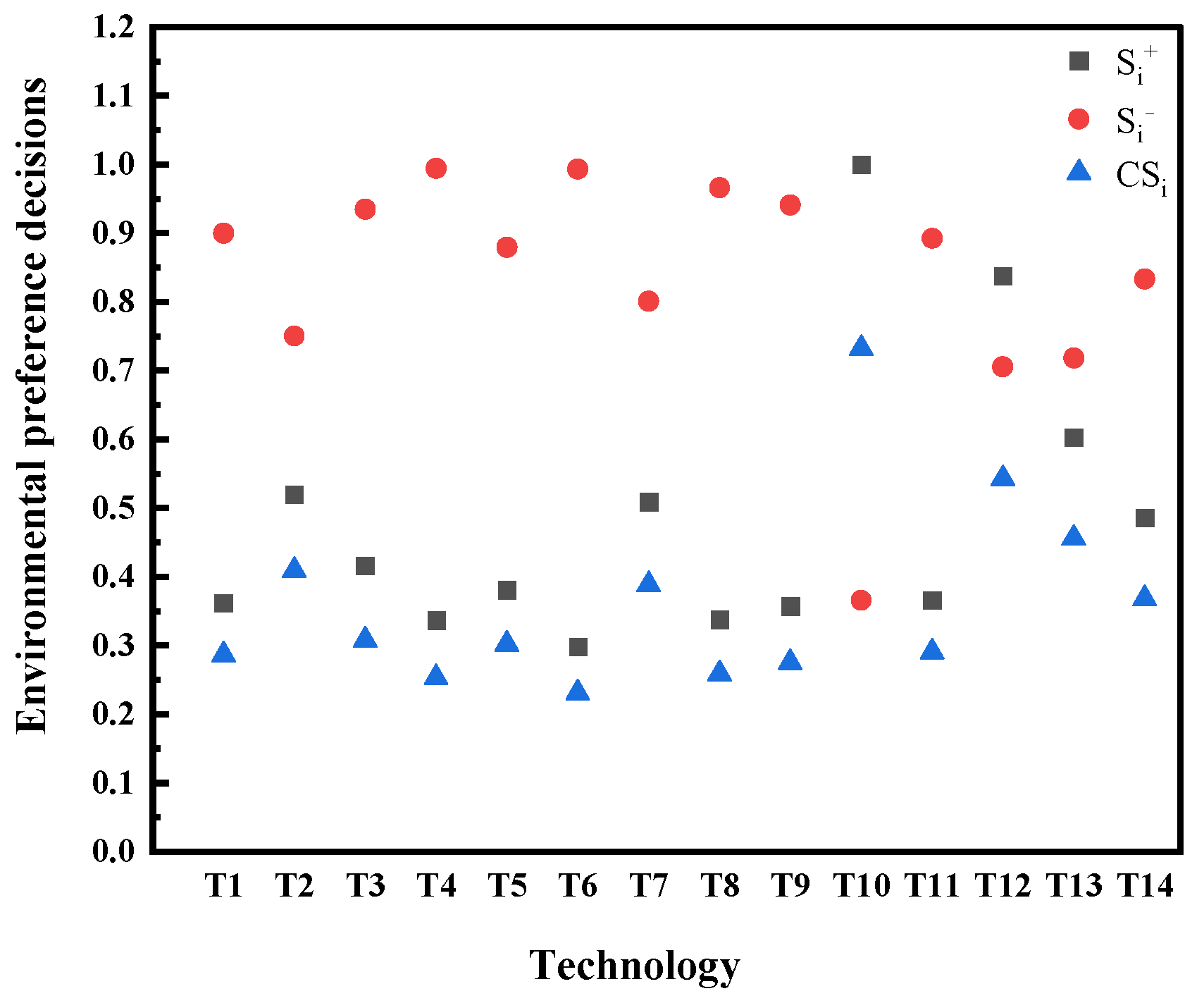
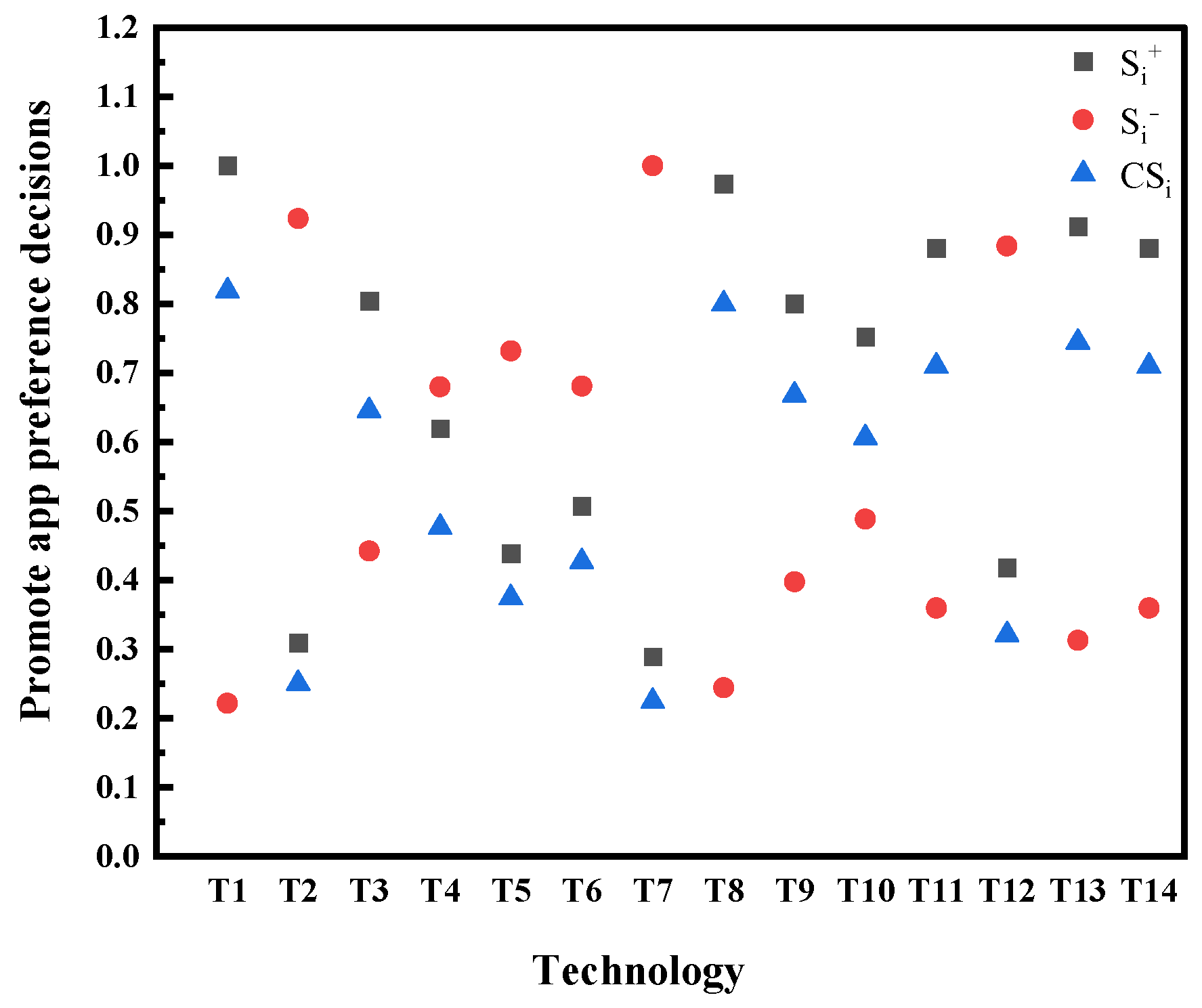
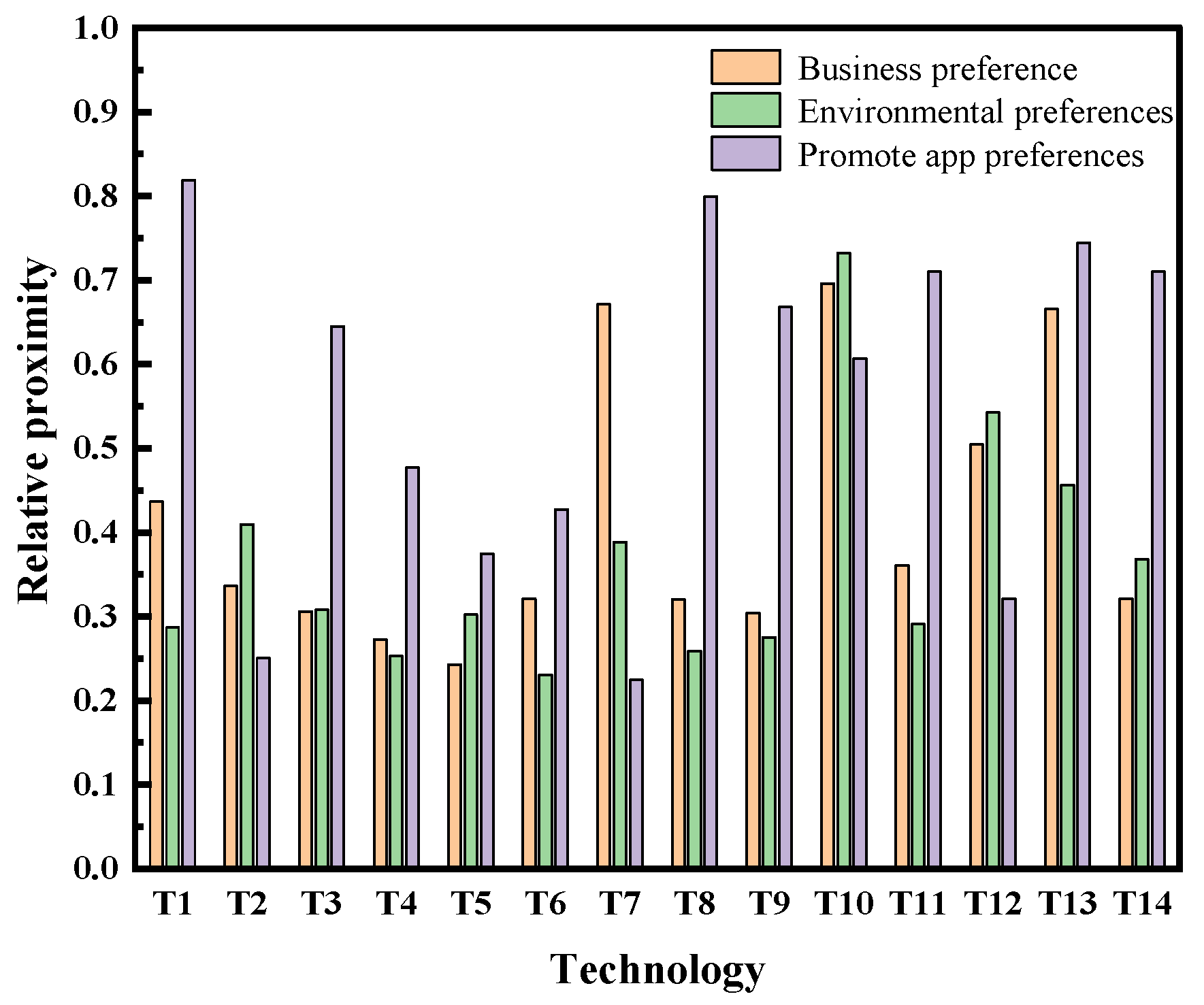
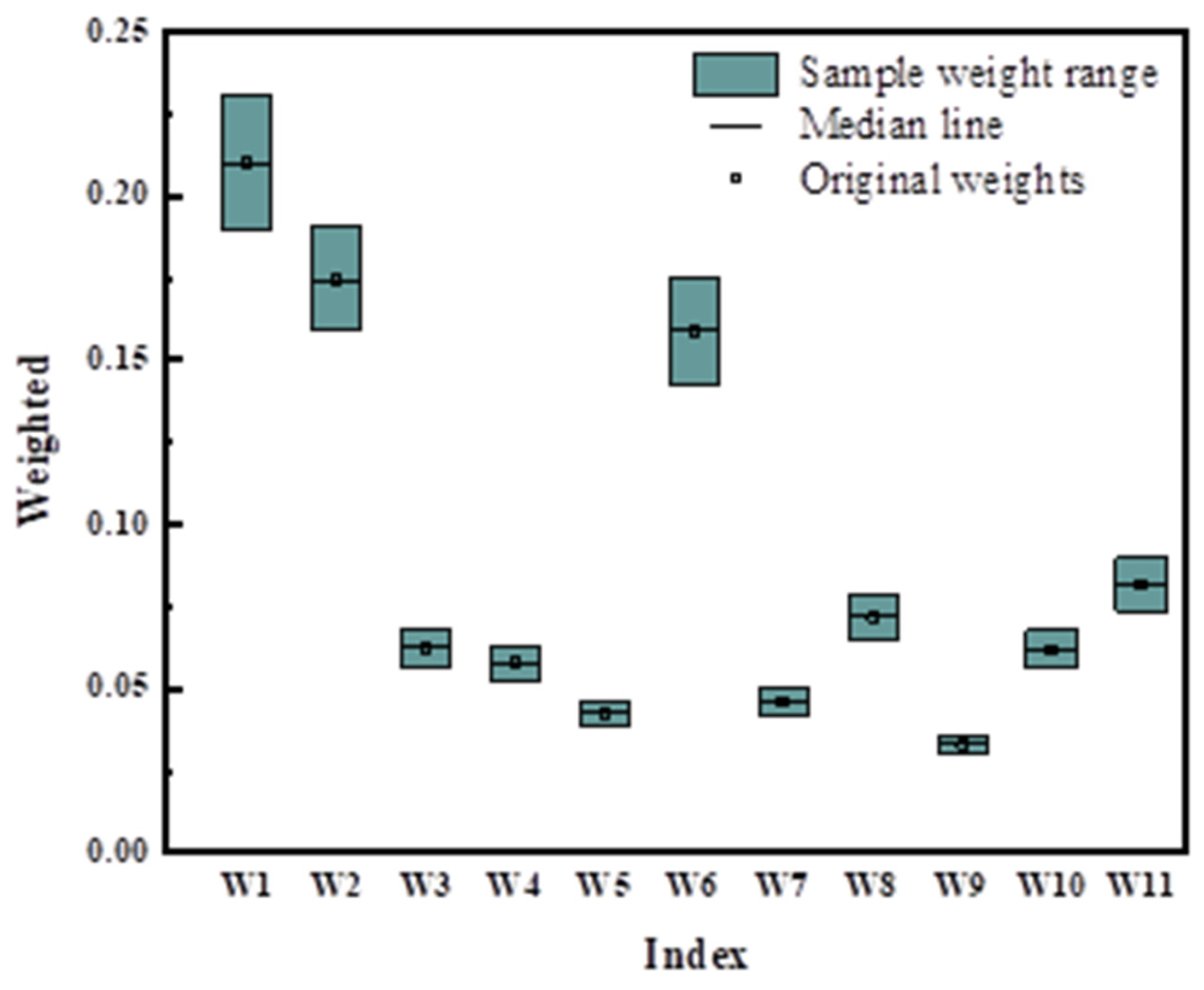
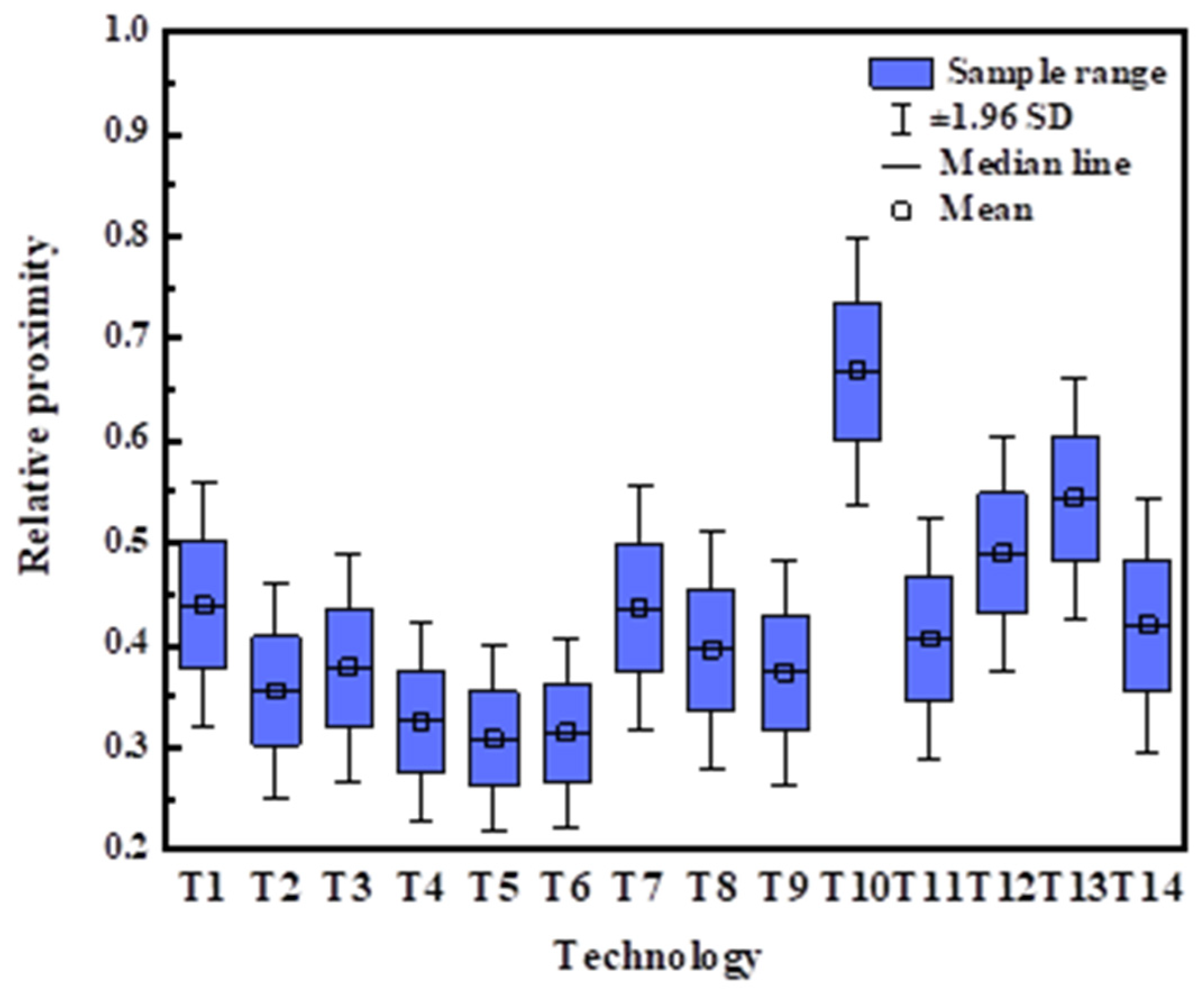
| Target Layer | Normative Layer | Indicator Layer |
|---|---|---|
| A comprehensive evaluation of flue gas desulphurisation technology in the iron and steel industry [17] | Technical indicator | System upgrade performance, adverse impact, system operational stability, technology maturity |
| Economic indicator | Infrastructure investment, unit desulphurisation cost, floor space | |
| Environmental indicator | Recovery performance of by products, secondary pollution, desulphurisation efficiency | |
| Assessment of symbiotic technologies in the steel industry [18] | Energy saving | |
| CO2 emission reduction | ||
| By product recovery rate | ||
| fixed-asset investment | ||
| Technology payback period | ||
| Technology penetration | ||
| Method | Advantage | Disadvantage |
|---|---|---|
| Expert scoring method | Simple methodology; Intuitive; Can be assessed even in the absence of informative data. | Highly subjective; Accuracy depends on expert perception and lacks objectivity. |
| Hierarchical analysis [19] | Simple and practical; Rigorous structure; Few quantitative information needs; Highly operational. | Too many qualitative components, too subjective; Difficult to calculate when assessing more indicators; Unable to judge elements that think differently. |
| TOPSIS method [20] | Low sample requirements; Raw data are well utilised, close to the actual situation, strong objectivity. | Prone to reverse sequencing; Some situations cannot be judged and are not very sensitive; Programmes cannot be classified and managed. |
| Data envelopment analysis [21,22] | Stronger objectivity; Indicators do not need to be weighted; Data do not need to be dimensionless. | High demand for the number of decision-making units; Inability to reflect the actual situation of decision-making units; Inability to distinguish between levels of technical efficiency. |
| Grey correlation analysis [23] | Lower workload; Reduced losses from information asymmetry; Low data requirements. | Deficiencies in the overall assessment of the programme; Poor analysis of qualitative indicators; Sorting from curve shape similarity only; Inability to address similarity of indicator information. |
| Fuzzy integrated assessment method [24] | Simple and easy to grasp; Fuzzy problems quantified; Strong applicability; Ability to solve complex problems. | Indicator relevance is difficult to address; Excessive subjectivity; Inadequate assessment methodology. |
| Serial Number | Technical Name | Thrust |
|---|---|---|
| T1 | High-temperature and high-pressure dry coke quenching | Coke production is carried out under high-temperature and high-pressure conditions, The volatiles in the coal are rapidly evaporated and burned in a short period of time. |
| T2 | CO2 cycle device | The coke oven gas reacts with recycled CO2 separated from CO2-rich exhaust gas to produce syngas for synthetic natural gas production. |
| T3 | Sintering flue gas sensible heat recovery | The waste heat of the cooler is recovered by using the existing technology, which is mainly focused on the recovery of the waste heat flue gas of the cooler. |
| T4 | Sintering waste heat turbine | The waste heat of the flue gas generated by sintering is used to make the steam generated by the waste heat boiler output useful work of the steam turbine. |
| T5 | Sinter ore apparent heat utilisation by SCR of sinter ore flue gas | The waste heat of the sintering flue gas is purified. |
| T6 | Washable blast furnace slag sensible heat exchange | Recovery of sensible heat from blast furnace slag. |
| T7 | Blast furnace slag sensible heat coal gasification | High-value-added products are produced using slag and sensible heat. |
| T8 | Blast furnace gas residual pressure turbine power generation | The by product of blast furnace smelting is used to make the gas work through the turboexpander, which is converted into mechanical energy, which in turn is converted into electrical energy. |
| T9 | Fan power recovery turbine | A device that converts the kinetic energy of the wind into electrical energy. |
| T10 | Gas-fired combined cycle power generation | A combined cycle in which the exhaust gas from a gas turbine is used as a heating source circulating by a steam turbine unit. |
| T11 | Blast furnace gas boiler power generation | Low sulphur content and low dust concentration. |
| T12 | Methanol from coke oven and blast furnace gas | In the transformation of the circular industrial chain of the coking industry, coke oven gas is used as raw material to produce methanol. |
| T13 | Cement made from blast furnace slag | Hydration of clinker minerals, chemical reaction of slag powder with calcium hydroxide and calcium sulfate. |
| T14 | Steel slag to cement | The hydraulic cementitious material made of open-hearth furnace and converter steel slag is the main component, and granulated blast furnace slag and gypsum are added. |
| Index | Evaluation Details |
|---|---|
| Technology maturity | Score 9: Matured; Score 7: More mature; Score 5: Ordinary; Score 3: Not mature enough; Score 1: Immature |
| Technological advancement | Score 9: International advanced; Score 7: Domestic advanced; Score 5: Domestic average; Score 3: Backward in the country; Score 1: Domestic elimination |
| Technical stability | Score 9: Very stable; Score 7: Relatively stable; Score 5: Ordinary; Score 3: Poor; Score 1: Very unstable |
| Normative | Energy Saving (Kgce/t Products) | Carbon Reduction | Resource Recovery Rate % | Fixed Investment Costs (t Products) | Running Cost (t Products·a) | Economic Gain/(t Products·a) | Static Payback Period (a) | Technology Maturity | Technological Superiority | Technical Stability | Potential for Outreach % | |
|---|---|---|---|---|---|---|---|---|---|---|---|---|
| Technical | (kg/t Products) | |||||||||||
| T1 | 12.65 | 64 | 36.2 | 130 | 18.89 | 34.64 | 9.25 | 9 | 7 | 9 | 80 | |
| T2 | 19.31 | 168.81 | 79 | 15 | 30.84 | 39.46 | 2.74 | 5 | 3 | 5 | 10 | |
| T3 | 8.07 | 20 | 72.97 | 12.23 | 6.93 | 9.18 | 6.44 | 9 | 5 | 9 | 40 | |
| T4 | 4.61 | 10.43 | 41.78 | 12.5 | 6.36 | 13.5 | 2.75 | 9 | 5 | 5 | 10 | |
| T5 | 11.27 | 108.4 | 32.39 | 1 | 2.43 | 3.45 | 1.98 | 7 | 5 | 5 | 10 | |
| T6 | 7.12 | 18.83 | 21.06 | 13 | 1.29 | 3.02 | 8.51 | 7 | 5 | 7 | 10 | |
| T7 | 17.02 | 101.2 | 92.2 | 122.9 | 122.74 | 135.14 | 10.91 | 5 | 5 | 3 | 1 | |
| T8 | 5.53 | 36.72 | 39 | 16.37 | 4.16 | 6.51 | 7.97 | 9 | 7 | 9 | 75 | |
| T9 | 6.35 | 52.16 | 44.8 | 23.08 | 12.37 | 25.85 | 2.71 | 9 | 7 | 7 | 50 | |
| T10 | 76.75 | 509.62 | 51 | 164.45 | 93.25 | 189.92 | 2.7 | 9 | 7 | 7 | 30 | |
| T11 | 18.25 | 46.72 | 28 | 18.44 | 8.27 | 59.38 | 1.36 | 9 | 7 | 9 | 50 | |
| T12 | 94.62 | 45.5 | 10.86 | 22.42 | 63.72 | 120.84 | 1.39 | 5 | 7 | 3 | 20 | |
| T13 | 43.3 | 54 | 95 | 162.56 | 104.42 | 150 | 4.57 | 9 | 7 | 9 | 60 | |
| T14 | 8.35 | 144 | 80 | 24.62 | 19.57 | 27.93 | 3.94 | 9 | 7 | 9 | 50 | |
| Type of indicator | efficiency-based | efficiency-based | efficiency-based | cost-based | cost-based | efficiency-based | cost-based | efficiency-based | efficiency-based | efficiency-based | efficiency-based | |
| Indicator | Energy Saving w1 | Carbon Dioxide Emission Reduction w2 | Resource Recovery Rate w3 | Fixed Investment Cost w4 | Operating Cost w5 | Economic Return w6 |
| 0.210 | 0.174 | 0.062 | 0 | 0 | 0.159 | |
| 0 | 0 | 0 | 0.058 | 0.043 | 0 | |
| Indicator | Static payback period w7 | Technology maturity w8 | Technology advancement w9 | Technology stability w10 | Technology promotion potential w11 | |
| 0 | 0.072 | 0.033 | 0.062 | 0.082 | ||
| 0.046 | 0 | 0 | 0 | 0 |
| Technical | T1 | T2 | T3 | T4 | T5 | T6 | T7 | T8 |
| 0.286 | 0.283 | 0.317 | 0.334 | 0.316 | 0.334 | 0.267 | 0.318 | |
| 0.149 | 0.092 | 0.117 | 0.081 | 0.061 | 0.068 | 0.155 | 0.132 | |
| Technical | T9 | T10 | T11 | T12 | T13 | T14 | ||
| 0.309 | 0.087 | 0.283 | 0.227 | 0.205 | 0.286 | |||
| 0.109 | 0.313 | 0.128 | 0.237 | 0.215 | 0.135 |
| Technical | T1 | T2 | T3 | T4 | T5 | T6 | T7 |
| 0.286 | 0.283 | 0.317 | 0.334 | 0.316 | 0.334 | 0.267 | |
| 0.149 | 0.092 | 0.117 | 0.081 | 0.061 | 0.068 | 0.155 | |
| Technical | T8 | T9 | T10 | T11 | T12 | T13 | T14 |
| 0.318 | 0.309 | 0.087 | 0.283 | 0.227 | 0.205 | 0.286 | |
| 0.132 | 0.109 | 0.313 | 0.128 | 0.237 | 0.215 | 0.135 |
| Technical | ||||
|---|---|---|---|---|
| T1 | 0.854 | 0.474 | 0.881 | 0.840 |
| T2 | 0.846 | 0.293 | 0.729 | 0.957 |
| T3 | 0.950 | 0.374 | 0.809 | 0.926 |
| T4 | 1 | 0.260 | 0.741 | 1 |
| T5 | 0.946 | 0.196 | 0.713 | 0.998 |
| T6 | 0.998 | 0.218 | 0.736 | 0.997 |
| T7 | 0.799 | 0.496 | 0.831 | 0.879 |
| T8 | 0.951 | 0.422 | 0.838 | 0.912 |
| T9 | 0.925 | 0.348 | 0.794 | 0.922 |
| T10 | 0.260 | 1 | 1 | 0.725 |
| T11 | 0.846 | 0.408 | 0.810 | 0.896 |
| T12 | 0.679 | 0.757 | 0.w802 | 0.925 |
| T13 | 0.615 | 0.688 | 0.953 | 0.749 |
| T14 | 0.855 | 0.431 | 0.840 | 0.868 |
| Preference Factor | |||||||||
|---|---|---|---|---|---|---|---|---|---|
| technical | |||||||||
| T1 | 0.881 | 0.840 | 0.512 | 0.678 | 0.847 | 0.444 | 0.474 | 0.854 | 0.357 |
| T2 | 0.729 | 0.957 | 0.432 | 0.511 | 0.902 | 0.362 | 0.293 | 0.846 | 0.257 |
| T3 | 0.809 | 0.926 | 0.466 | 0.592 | 0.938 | 0.387 | 0.374 | 0.950 | 0.283 |
| T4 | 0.741 | 1 | 0.426 | 0.500 | 1 | 0.334 | 0.260 | 1 | 0.206 |
| T5 | 0.713 | 0.999 | 0.417 | 0.454 | 0.972 | 0.318 | 0.196 | 0.947 | 0.171 |
| T6 | 0.736 | 0.998 | 0.425 | 0.477 | 0.997 | 0.324 | 0.218 | 0.998 | 0.179 |
| T7 | 0.831 | 0.879 | 0.486 | 0.663 | 0.839 | 0.442 | 0.496 | 0.799 | 0.383 |
| T8 | 0.838 | 0.912 | 0.479 | 0.630 | 0.932 | 0.403 | 0.422 | 0.951 | 0.307 |
| T9 | 0.795 | 0.922 | 0.463 | 0.571 | 0.924 | 0.382 | 0.348 | 0.925 | 0.273 |
| T10 | 1 | 0.725 | 0.580 | 1 | 0.493 | 0.670 | 1 | 0.260 | 0.794 |
| T11 | 0.810 | 0.896 | 0.475 | 0.609 | 0.871 | 0.411 | 0.408 | 0.846 | 0.325 |
| T12 | 0.802 | 0.925 | 0.465 | 0.780 | 0.802 | 0.493 | 0.757 | 0.679 | 0.527 |
| T13 | 0.953 | 0.749 | 0.560 | 0.820 | 0.682 | 0.546 | 0.688 | 0.615 | 0.528 |
| T14 | 0.840 | 0.868 | 0.492 | 0.636 | 0.861 | 0.425 | 0.431 | 0.855 | 0.335 |
| sorted | T10 > T13 > T1 > T14 > T7 > T8 > T11 > T3 > T12 > T9 > T2 > T4 > T6 > T5 | T10 > T13 > T12 > T1 > T7 > T14 > T11 > T8 > T3 > T9 > T2 > T4 > T6 > T5 | T10 > T13 > T12 > T7 > T1 > T14 > T11 > T8 > T3 > T9 > T2 > T4 > T6 > T5 | ||||||
Disclaimer/Publisher’s Note: The statements, opinions and data contained in all publications are solely those of the individual author(s) and contributor(s) and not of MDPI and/or the editor(s). MDPI and/or the editor(s) disclaim responsibility for any injury to people or property resulting from any ideas, methods, instructions or products referred to in the content. |
© 2024 by the authors. Licensee MDPI, Basel, Switzerland. This article is an open access article distributed under the terms and conditions of the Creative Commons Attribution (CC BY) license (https://creativecommons.org/licenses/by/4.0/).
Share and Cite
Yang, X.; Wang, H.; Gu, Y.; Liu, W.; Pan, C. Comprehensive Assessment and Empirical Research on Green and Low-Carbon Technologies in the Steel Industry. Processes 2024, 12, 397. https://doi.org/10.3390/pr12020397
Yang X, Wang H, Gu Y, Liu W, Pan C. Comprehensive Assessment and Empirical Research on Green and Low-Carbon Technologies in the Steel Industry. Processes. 2024; 12(2):397. https://doi.org/10.3390/pr12020397
Chicago/Turabian StyleYang, Xinyue, Hao Wang, Yueqing Gu, Wenjie Liu, and Chongchao Pan. 2024. "Comprehensive Assessment and Empirical Research on Green and Low-Carbon Technologies in the Steel Industry" Processes 12, no. 2: 397. https://doi.org/10.3390/pr12020397
APA StyleYang, X., Wang, H., Gu, Y., Liu, W., & Pan, C. (2024). Comprehensive Assessment and Empirical Research on Green and Low-Carbon Technologies in the Steel Industry. Processes, 12(2), 397. https://doi.org/10.3390/pr12020397





